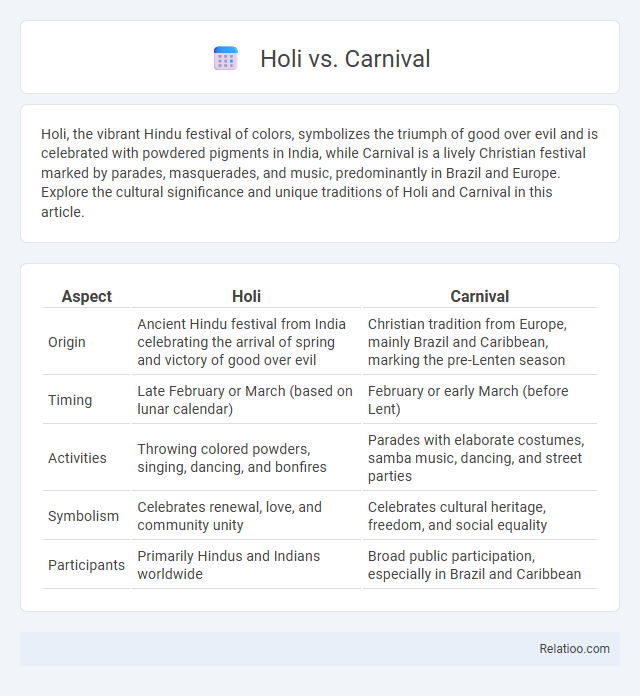Holi, the vibrant Hindu festival of colors, symbolizes the triumph of good over evil and is celebrated with powdered pigments in India, while Carnival is a lively Christian festival marked by parades, masquerades, and music, predominantly in Brazil and Europe. Explore the cultural significance and unique traditions of Holi and Carnival in this article.
Table of Comparison
| Aspect | Holi | Carnival |
|---|---|---|
| Origin | Ancient Hindu festival from India celebrating the arrival of spring and victory of good over evil | Christian tradition from Europe, mainly Brazil and Caribbean, marking the pre-Lenten season |
| Timing | Late February or March (based on lunar calendar) | February or early March (before Lent) |
| Activities | Throwing colored powders, singing, dancing, and bonfires | Parades with elaborate costumes, samba music, dancing, and street parties |
| Symbolism | Celebrates renewal, love, and community unity | Celebrates cultural heritage, freedom, and social equality |
| Participants | Primarily Hindus and Indians worldwide | Broad public participation, especially in Brazil and Caribbean |
Introduction to Holi and Carnival
Holi, known as the Festival of Colors, originates from India and celebrates the arrival of spring with vibrant color powders symbolizing joy and the victory of good over evil. Carnival, widely renowned in Brazil and other countries, is a grand pre-Lenten festival featuring elaborate parades, samba music, and extravagant costumes designed to showcase cultural heritage and community spirit. Both Holi and Carnival engage thousands of participants in unique, festive experiences rooted in historical and religious traditions.
Historical Origins of Holi and Carnival
Holi, originating from ancient India, is deeply rooted in Hindu mythology celebrating the victory of good over evil and the arrival of spring with vibrant colors and joyous rituals. Carnival traces its origins to European pre-Lenten festivities, particularly in Italy and France, symbolizing a last period of feasting and celebration before Lent's fasting begins. Understanding these historical origins enriches your appreciation of how Holi and Carnival uniquely express cultural heritage through their distinctive traditions and symbolism.
Cultural Significance of Holi
Holi, known as the Festival of Colors, holds profound cultural significance in India, symbolizing the victory of good over evil and the arrival of spring. Unlike Carnival, which is rooted in Christian traditions and characterized by elaborate parades and masks, Holi emphasizes social harmony by encouraging people to forget caste and social barriers through vibrant color throwing and festive gatherings. Your participation in Holi connects you to ancient mythology and promotes unity, renewal, and joyous celebration within communities.
Cultural Importance of Carnival
Carnival holds significant cultural importance as it celebrates community identity, heritage, and artistic expression through vibrant parades, music, and dance. Unlike Holi, which centers on the Hindu festival of colors symbolizing the arrival of spring, and general festivals that may honor religious or seasonal events, Carnival embodies multiculturalism and social unity in many regions, especially in Latin America and Europe. Your participation in Carnival connects you to a rich tradition of cultural storytelling and collective celebration.
Key Traditions and Rituals
Holi, the Indian festival of colors, features vibrant color throwing, singing, dancing, and the symbolic burning of Holika to celebrate the triumph of good over evil. Carnival, primarily observed in countries like Brazil and Italy, emphasizes elaborate parades, samba music, masquerade balls, and lavish costumes to mark the pre-Lenten festivity. Festivals encompass a wide range of cultural, religious, or historical events, often including traditional rituals, community gatherings, special foods, and performances unique to each celebration.
Color and Costume Symbolism
Holi, the Indian festival of colors, symbolizes the triumph of good over evil through vibrant powders and traditional white clothing that highlights the explosion of hues. Carnival, especially in Brazil, showcases elaborate costumes and masks representing cultural heritage, freedom, and social satire, often featuring bright colors and intricate designs to celebrate life and diversity. Festivals worldwide use colors and costumes to express identity, spirituality, and communal joy, with each tradition embedding specific symbolism that reflects historical and cultural narratives.
Major Locations and Celebrations
Holi, primarily celebrated in India and Nepal, features vibrant colors and water-throwing activities symbolizing the arrival of spring and the victory of good over evil. Carnival is famously observed in Brazil, especially in Rio de Janeiro, with massive parades, samba music, and elaborate costumes marking the pre-Lenten festivities. Festivals such as Oktoberfest in Germany and Mardi Gras in New Orleans showcase cultural heritage through food, music, and community gatherings, offering your chance to experience diverse global celebrations.
Differences in Religious Influences
Holi is a Hindu festival deeply rooted in ancient mythology and spiritual symbolism, celebrating the victory of good over evil through vibrant colors and rituals. Carnival, primarily associated with Christian traditions, especially Catholicism, marks the period before Lent with festive parades, music, and indulgence. Your understanding of these events highlights that festivals like Holi emphasize religious devotion, while Carnival blends cultural celebration with religious observance, and other festivals may vary widely in spiritual significance.
Similarities in Festive Spirit
Holi, Carnival, and Festival celebrations all embody a vibrant showcase of joy, community bonding, and cultural expression through music, dance, and colorful displays. These events emphasize the spirit of togetherness and renewal, where participants actively engage in rituals that foster unity and happiness. Your experience in any of these festivities will immerse you in a lively atmosphere that celebrates life and shared human connection.
Modern-Day Celebrations and Global Influence
Modern-day celebrations of Holi, Carnival, and various global festivals showcase vibrant cultural expressions that attract millions worldwide. Holi, known as the Festival of Colors, has transcended its Indian origins, with events in major cities promoting unity and joy through colored powders. Your participation in these festivals connects you to a global community celebrating diversity, music, dance, and tradition beyond geographic boundaries.

Infographic: Holi vs Carnival
 relatioo.com
relatioo.com